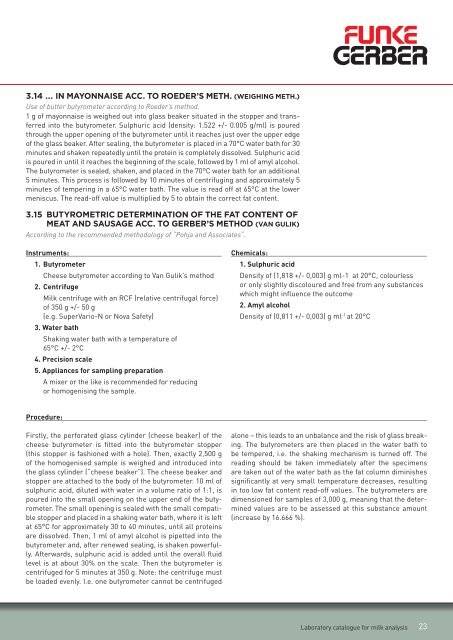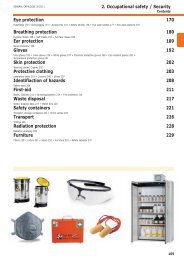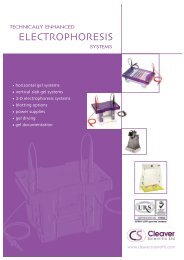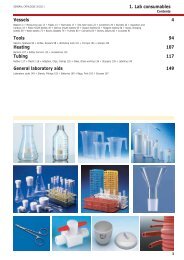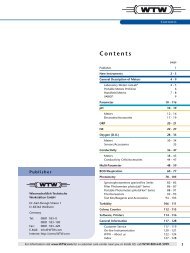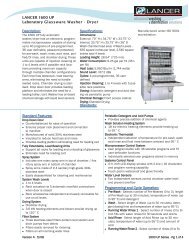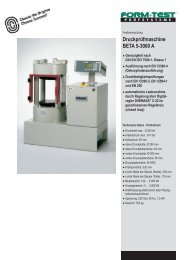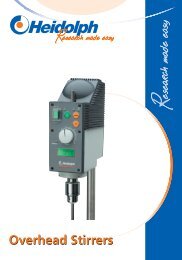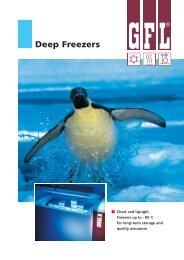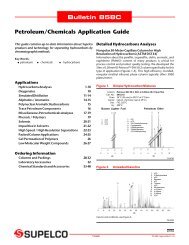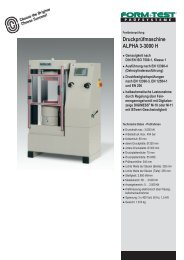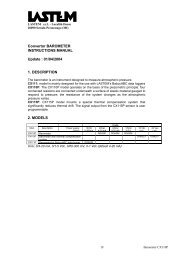LABORATORY CATALOGUE for milk analysis - Labochema
LABORATORY CATALOGUE for milk analysis - Labochema
LABORATORY CATALOGUE for milk analysis - Labochema
You also want an ePaper? Increase the reach of your titles
YUMPU automatically turns print PDFs into web optimized ePapers that Google loves.
3.14 ... in mayonnaise acc. to Roeder’s meth. (weighing meth.)<br />
Use of butter butyrometer according to Roeder’s method.<br />
1 g of mayonnaise is weighed out into glass beaker situated in the stopper and transferred<br />
into the butyrometer. Sulphuric acid (density: 1.522 +/- 0.005 g/ml) is poured<br />
through the upper opening of the butyrometer until it reaches just over the upper edge<br />
of the glass beaker. After sealing, the butyrometer is placed in a 70°C water bath <strong>for</strong> 30<br />
minutes and shaken repeatedly until the protein is completely dissolved. Sulphuric acid<br />
is poured in until it reaches the beginning of the scale, followed by 1 ml of amyl alcohol.<br />
The butyrometer is sealed, shaken, and placed in the 70°C water bath <strong>for</strong> an additional<br />
5 minutes. This process is followed by 10 minutes of centrifuging and approximately 5<br />
minutes of tempering in a 65°C water bath. The value is read off at 65°C at the lower<br />
meniscus. The read-off value is multiplied by 5 to obtain the correct fat content.<br />
3.15 butyrometric determination of the fat content of<br />
meat and sausage acc. to Gerber’s method (Van Gulik)<br />
According to the recommended methodology of “Pohja and Associates“.<br />
Instruments:<br />
1. Butyrometer<br />
Cheese butyrometer according to Van Gulik’s method<br />
2. Centrifuge<br />
Milk centrifuge with an RCF (relative centrifugal <strong>for</strong>ce)<br />
of 350 g +/- 50 g<br />
(e.g. SuperVario-N or Nova Safety)<br />
3. Water bath<br />
Shaking water bath with a temperature of<br />
65°C +/- 2°C<br />
4. Precision scale<br />
5. Appliances <strong>for</strong> sampling preparation<br />
A mixer or the like is recommended <strong>for</strong> reducing<br />
or homogenising the sample.<br />
Chemicals:<br />
1. Sulphuric acid<br />
Density of (1,818 +/- 0,003) g ml-1 at 20°C, colourless<br />
or only slightly discoloured and free from any substances<br />
which might influence the outcome<br />
2. Amyl alcohol<br />
Density of (0,811 +/- 0,003) g ml -1 at 20°C<br />
Procedure:<br />
Firstly, the per<strong>for</strong>ated glass cylinder (cheese beaker) of the<br />
cheese butyrometer is fitted into the butyrometer stopper<br />
(this stopper is fashioned with a hole). Then, exactly 2,500 g<br />
of the homogenised sample is weighed and introduced into<br />
the glass cylinder (“cheese beaker”). The cheese beaker and<br />
stopper are attached to the body of the butyrometer. 10 ml of<br />
sulphuric acid, diluted with water in a volume ratio of 1:1, is<br />
poured into the small opening on the upper end of the butyrometer.<br />
The small opening is sealed with the small compatible<br />
stopper and placed in a shaking water bath, where it is left<br />
at 65°C <strong>for</strong> approximately 30 to 40 minutes, until all proteins<br />
are dissolved. Then, 1 ml of amyl alcohol is pipetted into the<br />
butyrometer and, after renewed sealing, is shaken powerfully.<br />
Afterwards, sulphuric acid is added until the overall fluid<br />
level is at about 30% on the scale. Then the butyrometer is<br />
centrifuged <strong>for</strong> 5 minutes at 350 g. Note: the centrifuge must<br />
be loaded evenly. I.e. one butyrometer cannot be centrifuged<br />
alone – this leads to an unbalance and the risk of glass breaking.<br />
The butyrometers are then placed in the water bath to<br />
be tempered, i.e. the shaking mechanism is turned off. The<br />
reading should be taken immediately after the specimens<br />
are taken out of the water bath as the fat column diminishes<br />
significantly at very small temperature decreases, resulting<br />
in too low fat content read-off values. The butyrometers are<br />
dimensioned <strong>for</strong> samples of 3,000 g, meaning that the determined<br />
values are to be assessed at this substance amount<br />
(increase by 16.666 %).<br />
Laboratory catalogue <strong>for</strong> <strong>milk</strong> <strong>analysis</strong><br />
23


